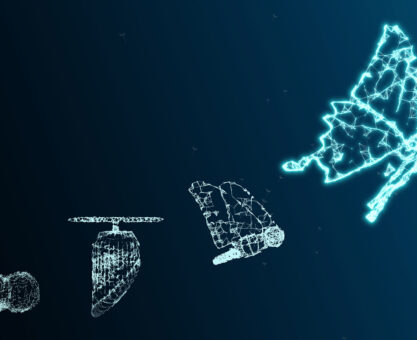In field service, much like in every other industry, the central discussions in boardrooms, at industry conferences and across the trade press are all heavily weighted around the concept of digital transformation and digitalization…
Indeed, much has been written about the topic across the last few years as we have seen the use of newly emerged technologies such as the Internet of Things, Artificial Intelligence and Augmented Reality increasingly become common place within our sector – certainly, at least with organisations who exist within the upper echelons of best-in-class service delivery standards.
Yet there is still a feeling that we are only just really beginning to scratch the surface when it comes to the true potential of what being digital can mean within the field service realm.
In the March iteration of the Field Service News Think Tank Sessions it was therefore understandable that the discussion would naturally be drawn somewhat towards this hugely prevalent industry talking point.
It was truly insightful to see how the group held shared challenges and how they were able to bring their own perspectives, and outline the approaches that have worked within their respective businesses to overcoming these issues.
Yet, what was truly fascinating was the different positive outcomes that these organisations had also discovered as a direct result of embracing digitalisation that go far beyond the often touted headlines we see. From building bridges between different departments, closing the skills-shortage, to adding competitive advantages there were a number of opportunities that one might not think of straight away when we think of digitalisation.
Although perhaps one of the most pressing aspects of the digital transformation conversation that is truly pervasive remains the perennial question of how do we monetise our advancements in this area?
“Even though remote services have been around for quite some time, the area is still seen as an emerging technology because it changes so often and certainly from an adoption perspective it is still emerging.”
– Coen Jeukens, ServiceMax
Indeed, one of the most widely cited reasons for companies embracing IoT and connectivity is the increasing drive towards advanced services and adapting to an outcome based world.
However, while in theory such moves bring great benefits to both the customer and the manufacturer alike, transforming a business from one that has been product centric to one where service is the primary revenue generator is a complex undertaking.
As Coen Jeukens, VP Global Customer Transformation, ServiceMax explained “We see that although remote service technology has been available for over 25 years there are still a lot of challenges in terms of getting data off site. In fact, even though remote services have been around for quite some time, the area is still seen as an emerging technology because it changes so often and certainly from an adoption perspective it is still emerging. I think that with all the conversations around cyber-security and data threats, all companies are revisiting each and every new technology out there.
“However, if or when we start using these technologies, the question is how do they tap into the service-centricity? “When we start investigating these technologies should we be involving the people from our commercial departments who are creating the services portfolios?”
The questions Jeukens raised were important ones and the importance of collaboration between the commercial and operations divisions within the business was acknowledged across the group.
“We are on the road to advanced services and have islands of success.” replied Eddie Storan, Head of Global Services, Domino Printing Sciences.
“We know this is a journey and it is very important that we involve all stakeholders within the business, as it involves a mind shift within the organisation where service transitions from being a bolt on to the sale and overall operations to one of a true reoccurring revenue generator.
“What we are finding is that it is much easier for us to service equipment if we can access the data remotely – so we are incentivised to make remote service a standard service offering.”
– Peter Deeming, Varian
“One of the important hurdles to overcome is changing the mindset from design of equipment all the way to commercial,” he added.
What was interesting was that within certain industries the concepts of remote services had matured to the point that they were no longer a USP but now an expectation. One such space where this has occurred is the med-tech sector and the result of this maturation of the technology has meant that the revenue models around remote assistance have also had to evolve.
As Peter Deeming, Service Tools Manager, Varian explained “In the medical industry our real obstacle lies in getting connection to our machines is GDPR and patient privacy. More and more we are finding customers are reluctant to allow access to our machines. However, what is really interesting to me is that 25 years ago when we were rolling out remote connectivity with dial-up modems, we were able to introduce these services and were charging a premium for the connectivity as it meant we could reach our clients machines and initiate a resolution that much quicker. Plus at that time remote connectivity was very much seen as the latest innovation.
”Today, the scenario is quite different, and what we are finding is that it is much easier for us to service equipment if we can access the data remotely – so we are incentivised to make remote service a standard service offering. So in terms of revenue the conversation around remote services for us has come full circle and we now rely on remote capabilities to reduce our cost of service,” he added.
Perhaps the most crucial aspect of monetising advanced services is being able to understand exactly what problems you are resolving for your customers and for most companies this can mean presenting different solutions to different customers that you serve.
To achieve this we need a deeper understanding of what service innovation means within our business than is often understood.
“The best practice here is in fact to combine our internal aims with an understanding of the problems are we solving for our clients.”
– Jan van Veen, MoreMomentum
As Jan van Veen, founder moreMomentum explained, “As service providers and manufacturers we often tend to focus on just one or two aspects of innovation. For example, we have a technology such as IoT or connectivity and we start working on that technology and we are pushing it out to our customer base.
Often it is the case then that the voice of the customer projects we run become more about how we can find the best hooks to further push the product out.
“In such scenarios, we can have a lot of blinkers when we are talking to our clients and often tend to only hear what we want to hear in relation to what we are looking for in line with the projects we have our internal focus on. The best practice here is in fact to combine our internal aims with an understanding of the problems are we solving for our clients and to which extent is that specific to a particular market segment or customer segment.
“For example, are we working towards something geared towards the Mom and Pop shops or towards large corporations? Is it a solution for the lean and mean companies or for very technology driven companies? Then we can start looking at what is the value proposition? What is the business model around it? How will the pricing model work? And ultimately, how do we start to sell it?
“When we start involving four, five or six tracks together we can start to see a viable solution emerge, because it is now one complete, marketable solution that is being developed. So the chances of hitting the mark and having a solution you can grow is now much bigger rather than if you just focus on one aspect. By doing this you will also have an automatic balance between pull and push. You will have technology, capabilities, processes and value pricing all in one innovation project.
“The other thing I think is quite important to consider here is that if it is quite new to the thinking of the core business of your company, or quite new to your clients, then it is advisable to establish a satellite team separate to the operating part of the organisation. This team should be tasked with finding the right market, understanding the needs, the proposition, the technologies etc and for them to bring it to the market. Let them find success without bothering the operating organisation.
“However, if the new project is quite close to the core business model, then a project team blended into the operating side of the organisation may work better. That is because in this case scenario pushing the development too far away from the core business can limit the chances to share synergies and learnings.”
Establishing advanced services-based revenue strategies is far from easy, as the old adage goes, if it were easy everybody would be doing it. However, there is an obvious desire from companies across all sectors to seek out the promises of longer contracts and greater profitability that would make all of this hard work worth it.
Want to know more? There is an Executive Briefing from this Field Service Think Tank Session available in the premium resource library.













